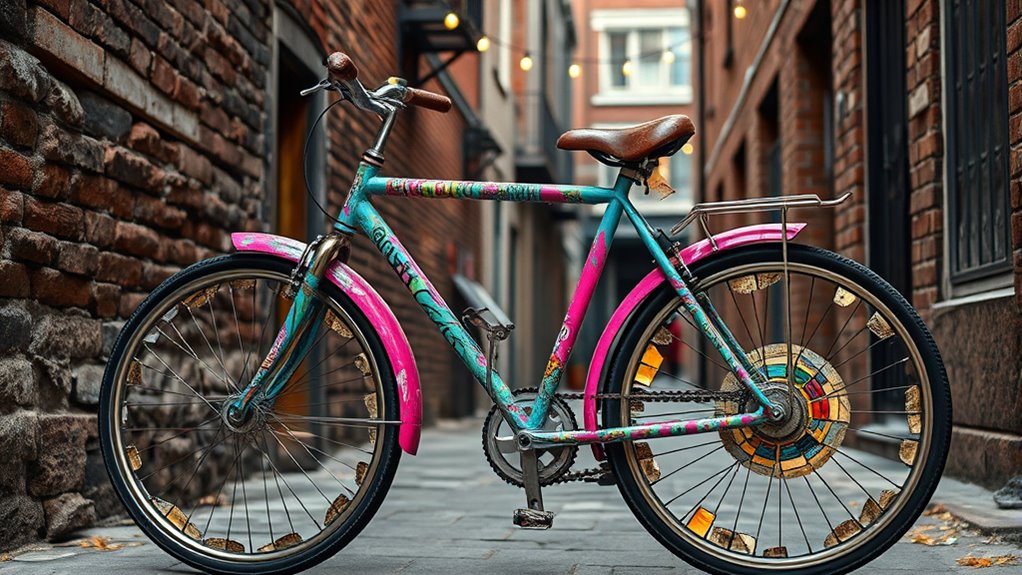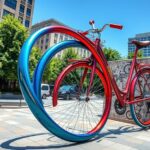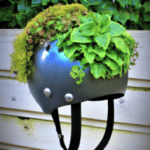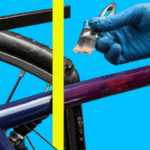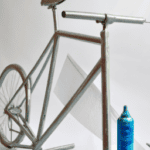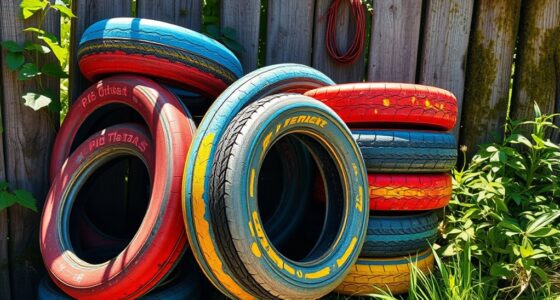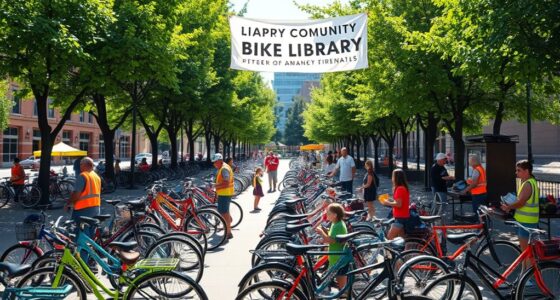Transforming your old bike into urban art is a fantastic way to boost community pride and promote sustainability. You can create sculptures using non-welding techniques like bolting, gluing, or adding metal brackets, while carefully selecting and prepping parts—cleaning, sanding, and painting them—that reflect your theme. Designing your piece thoughtfully guarantees safety and visual impact. To discover inspiring examples, techniques, and tips for showcasing your upcycled bike art, keep exploring—you’ll find plenty of ideas to start your project.
Key Takeaways
- Select and clean old bike parts, then disassemble to prepare for creative assembly without welding.
- Use mechanical fasteners, strong adhesives, or brackets to assemble bike parts into sculptures or installations.
- Design a theme or concept, sketch your idea, and plan the layout before construction.
- Incorporate upcycled components like chains, wheels, and frames to enhance visual interest and sustainability.
- Display your urban bike art in public spaces, ensuring durability and safety with weatherproof coatings and supportive structures.
Inspiring Examples of Bike-Based Sculptures and Installations
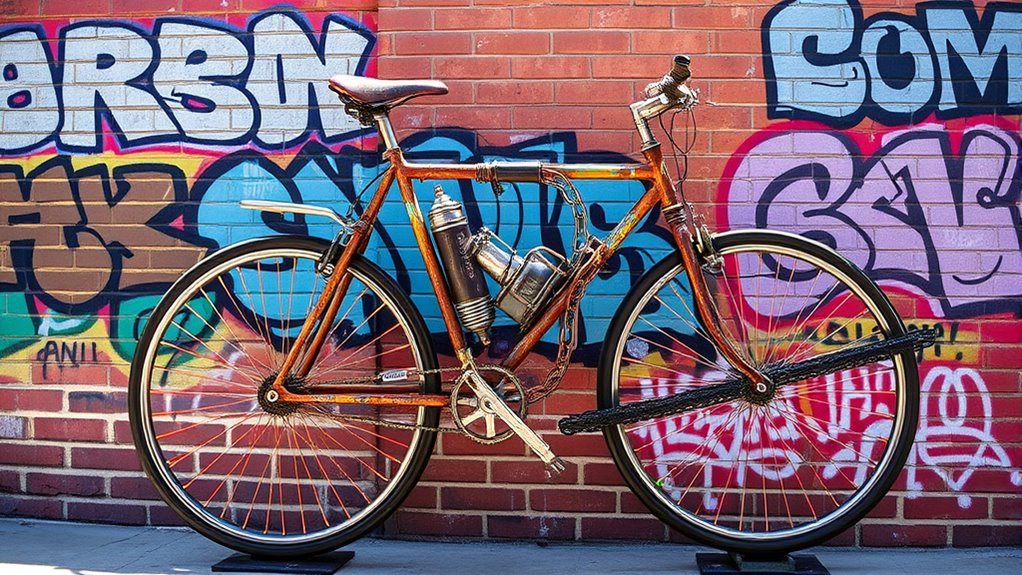
Around the world, artists transform old bikes into striking urban sculptures that inspire and engage communities. Recycled bicycles serve as the foundation for these creative installations, turning trash into powerful statements. In Toronto, the Arc de Vélo, built from 600 stolen bikes hung without welding, creates a temporary yet impactful sculpture. London’s Bermondsey Bike Tree features 35 recycled bikes harnessing sunlight and wind, emphasizing sustainability. In California, the Cyclisk, made from 340 donated bikes, stands 65 feet tall, celebrating transportation and community effort. At Burning Man, the Bike Arch, constructed from scrap bike parts, acts as both art and functional bike rack. These large-scale sculptures showcase how repurposing bikes can foster environmental awareness and community pride through innovative urban art. The use of recycled materials highlights the importance of sustainability in creating impactful public art. Additionally, understanding regulations and permits can ensure that such projects comply with local laws and are safely integrated into urban spaces. Incorporating fraud prevention tools in the planning process can also help protect creators from potential theft or vandalism during installation. Engaging with community organizations can further enhance support and visibility for these artistic initiatives. Furthermore, using digital mapping can help plan the installation process more efficiently and safely.
Techniques for Creating Bicycle Art Without Welding
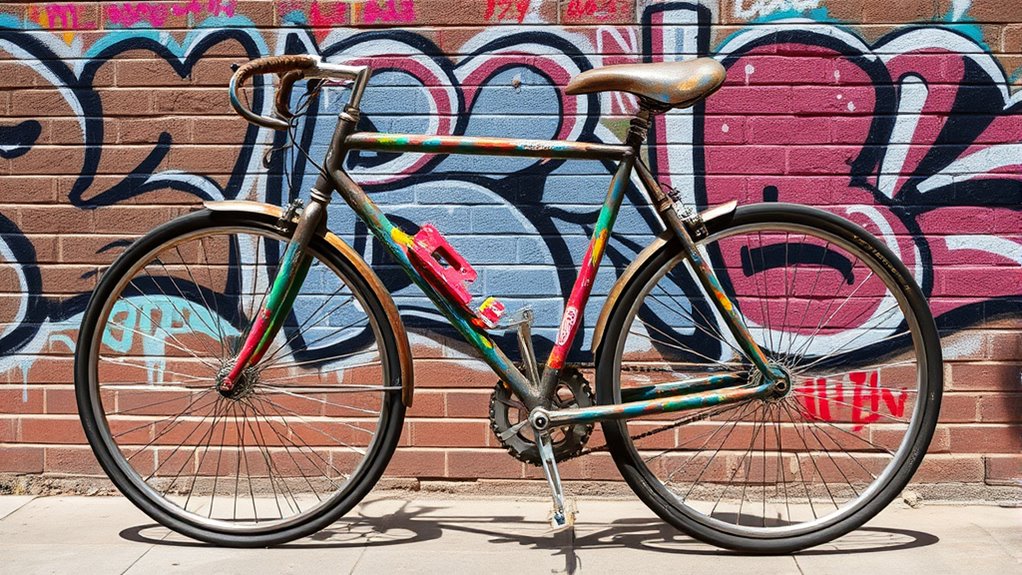
Creating bicycle art without welding relies on a variety of practical techniques that guarantee both stability and visual appeal. You can securely join bike parts using mechanical fasteners like bolts, nuts, and washers, ensuring your sculpture stays intact. For lightweight or decorative components, strong adhesives such as epoxy or industrial glue work well when attached to the frame. Reinforcing joints with metal brackets or straps adds extra stability, especially for outdoor displays or installations. Additionally, exploring creative assembly methods like interlocking or stacking bike wheels and frames allows you to form complex sculptures without welding. To ensure safety and durability, focus on precise measurement and proper fitting of parts. Utilizing an understanding of different art styles can inspire innovative designs and enhance the visual impact of your bicycle sculpture. Incorporating appropriate fastening techniques is essential to make your bicycle art secure, impressive, and ready to showcase your upcycling skills. Moreover, considering the use of quality materials can significantly improve the longevity and overall aesthetic of your artwork.
Selecting and Preparing Recycled Bike Parts for Artistic Projects
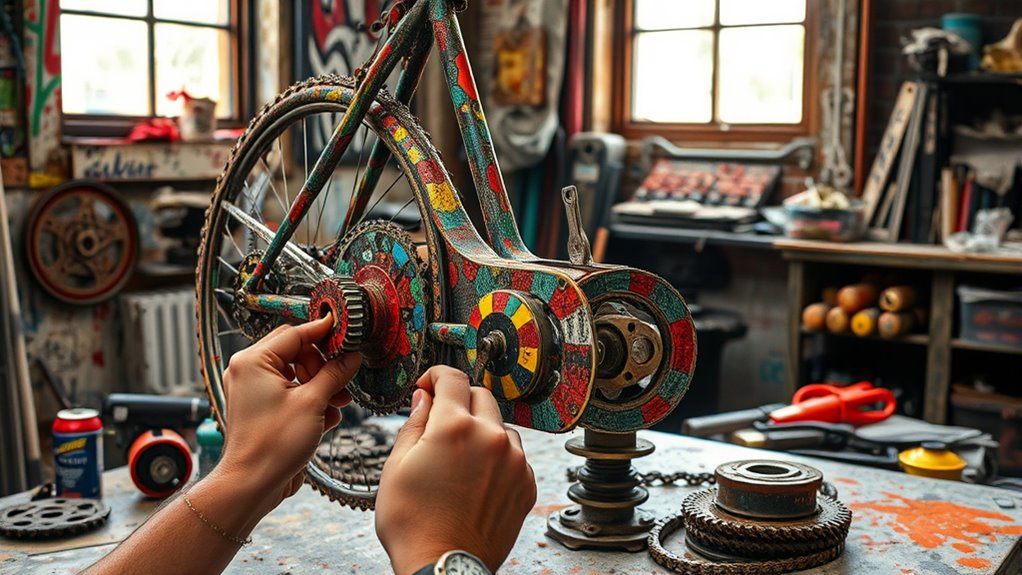
Before assembling your bicycle art, it’s important to carefully select and prepare the recycled bike parts. Start by inspecting each part from old bicycles for rust, dirt, or damage; clean or repair them as needed. Remove unnecessary components like tires, chains, and pedals to create a lightweight base. Sand surfaces with a wire brush or abrasive pads to improve paint adhesion and reveal shiny metal or vibrant colors. Choosing the right paint, such as spray paint or rust-resistant coatings, helps achieve your desired finish. Organizing parts by size and type to streamline assembly and measure them precisely for a proper fit. Use this table to visualize potential parts:
| Part | Condition/Preparation |
|---|---|
| Frame | Remove rust, sand, clean |
| Handlebars | Check for damage, sand for paint grip |
| Chain | Remove, clean, or replace if rusty |
| Pedals | Repair or replace if damaged |
| Wheels | Remove tires, clean, inspect for dents |
Focusing on upcycling strategies can further enhance your project by incorporating sustainable practices and creative reuse techniques. Additionally, exploring recycling methods can help you find innovative ways to repurpose more bike components effectively. Incorporating recycling regulations can also ensure your project complies with local environmental guidelines and promotes responsible reuse. Implementing creative reuse techniques can maximize the visual impact of your urban art while supporting eco-friendly initiatives. A thorough understanding of popular juice brands can provide inspiration for incorporating colorful, vibrant elements into your artwork, adding a lively visual appeal.
Designing and Planning Your Own Upcycled Bike Artwork
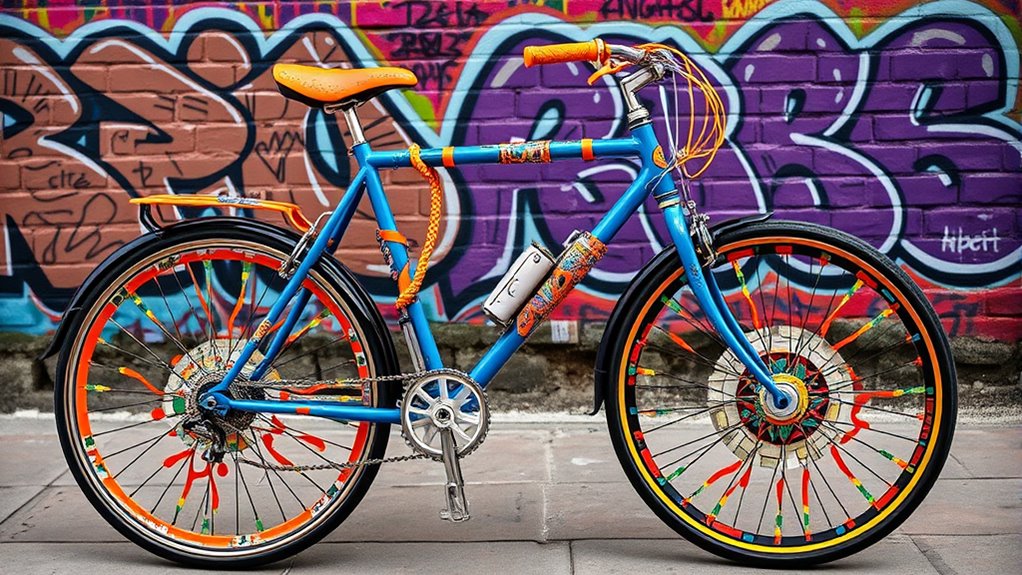
Start by choosing a concept and theme that reflect your style and fit your space, whether it’s a sculpture, wall art, or functional piece. Create detailed sketches to visualize your design and determine how each bike part fits together, making the building process smoother. Gather the necessary tools and materials, and consider environmental factors to guarantee your artwork is durable and safe for its intended location. Exploring electric bike conversion kits can inspire innovative ways to incorporate motor components or battery elements into your upcycled design, adding both aesthetic appeal and practical functionality. Additionally, understanding aesthetic principles can help you create a balanced and visually appealing piece that resonates with your personal style. Considering upcycling techniques can further enhance your project’s originality and sustainability. Consulting best practices in repurposing can also help optimize the use of materials and ensure your artwork is both creative and environmentally friendly. Incorporating sustainable design practices can elevate your project’s eco-friendliness while maintaining artistic integrity.
Concept and Theme Selection
Have you considered how a clear concept or theme can shape your upcycled bike into a cohesive piece of urban art? Choosing a strong theme guides your design choices and creates visual harmony. Think about ideas like sustainability, nostalgia, or abstract expression—these can reflect your message. To start, consider:
- Defining a central idea that resonates with you and complements your old bikes.
- Sketching multiple layout ideas, focusing on how bike parts can symbolize your theme.
- Picking a color palette that enhances your concept, whether through repainting frames or adding accents.
- Incorporating visual balance to ensure that all elements work harmoniously within your artwork. Paying attention to aesthetic principles can help achieve this harmony and make your upcycled art stand out, especially when considering design fundamentals that influence visual appeal.
Material and Design Planning
Evaluating your bike’s existing structure is an essential first step in planning your upcycled artwork. You need to identify which parts—wheels, handlebars, or even the bike chain—can be reused or repurposed. This assessment guides your design and guarantees stability. Choose a theme that matches your display space, whether a mural or sculpture, and plan your layout with detailed sketches. Consider the weight and balance of parts to prevent structural issues. Select materials like welding or bolting for attachment, and think about finishes that withstand weather. Here’s a quick guide to common parts:
| Part | Possible Upcycling Ideas |
|---|---|
| Bike Chain | Decorative accents or dynamic elements |
| Frame | Core structure or base sculpture |
| Handlebars | Creative framing or support structures |
| Wheels | Movement features or visual focal points |
Upcycling Bikes for Community Projects and Urban Beautification
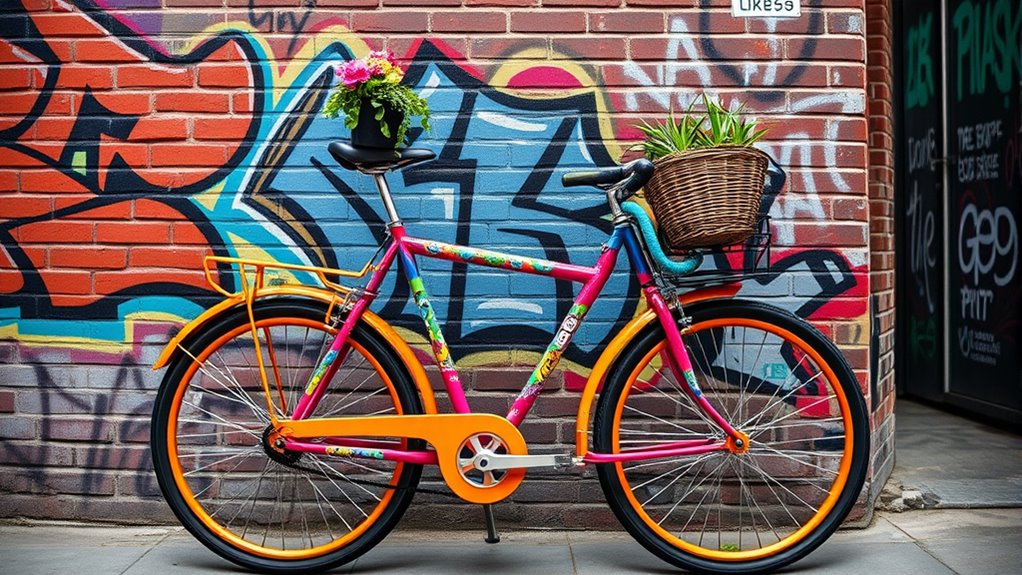
Upcycling bikes into community projects and urban beautification efforts transforms discarded bicycles into powerful symbols of sustainability and civic pride. By making sure old bicycles don’t end up on the scrap heap, you can turn them into striking public art that energizes neighborhoods. Here are some inspiring ways to do this:
Transform discarded bikes into vibrant public art that promotes sustainability and community pride.
- Use old bikes to create large-scale sculptures like Toronto’s Arc de Vélo, made from 600 bikes, to boost local aesthetics.
- Build installations like the Bermondsey Bike Tree with 35 recycled bikes, harnessing wind and sunlight to promote sustainability.
- Collaborate with nonprofits to donate refurbished bikes, encouraging creative reuse and fostering community engagement.
These projects not only beautify urban spaces but also celebrate cycling, environmental awareness, and neighborhood pride.
Tips for Maintaining Durability and Safety in Bike Art Installations
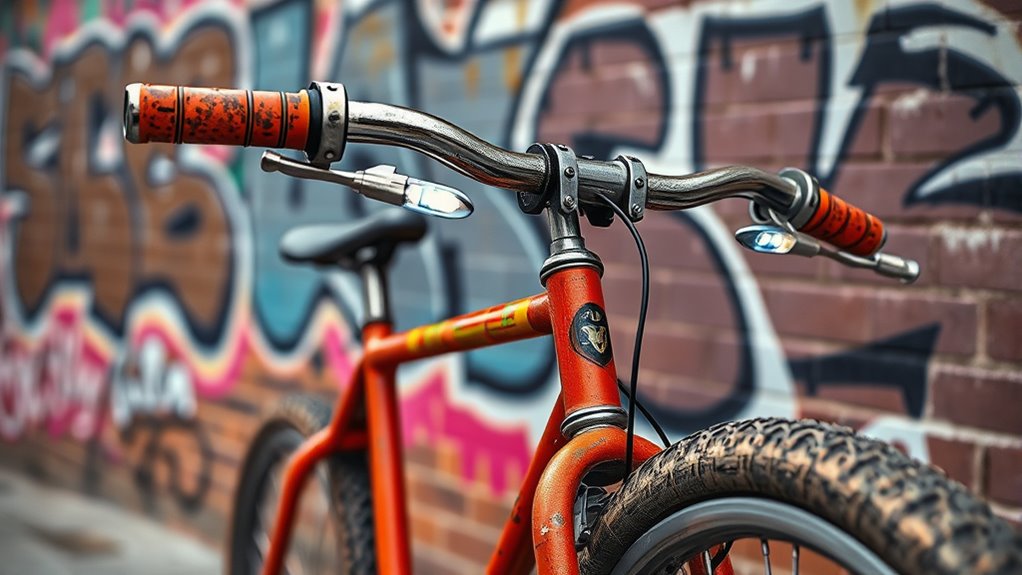
To keep your bike art installation safe and lasting, you need to focus on structural integrity and safety measures. Regular inspections for loose parts, rust, and damage are essential, and using weather-resistant materials helps prevent deterioration. By following these steps, you can make certain your artwork remains both durable and secure over time.
Ensuring Structural Integrity
Ensuring the structural integrity of your bike-based art installation is essential for safety and longevity. First, regularly inspect welded joints, fasteners, and load-bearing parts for signs of wear, rust, or fatigue that could weaken the structure. Second, reinforce critical areas by adding support brackets or cross braces, especially when repurposing bike frames for larger pieces. Third, keep weight distribution balanced to prevent tipping or collapse, particularly if heavy or multiple parts are involved. Use corrosion-resistant paints and sealants on outdoor installations to protect metal surfaces from rust and environmental damage. Finally, conduct load testing and stability assessments during construction and periodically afterward, confirming your art remains safe and durable over time.
Enhancing Safety Measures
Maintaining safety in your bike art installation requires consistent vigilance and proactive measures. Regularly inspect all structural components of your old bicycles for rust, corrosion, or metal fatigue to prevent accidents. Reinforce joints with welding or heavy-duty fasteners to ensure long-term durability. Apply corrosion-resistant coatings or sealants to exposed metal surfaces, especially if your artwork faces weather. Incorporate safety features like reflective paint, LED lights, or signage to improve visibility at night. Schedule routine maintenance checks to tighten bolts, replace worn parts, and assess stability, especially after severe weather or vandalism. Here’s a quick overview:
| Inspection Area | Maintenance Action | Safety Feature |
|---|---|---|
| Frame & Joints | Reinforce & weld | Reflective paint |
| Metal Surfaces | Sealant application | LED lights |
| Fasteners & Bolts | Tighten & replace | Signage |
Showcasing Your Upcycled Bicycle Art to the Public
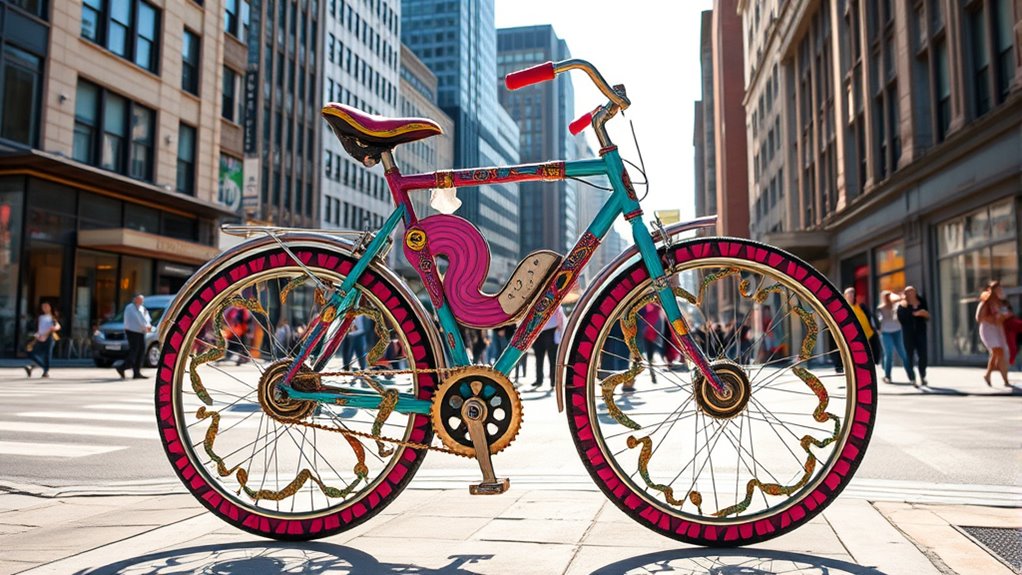
Showcasing your upcycled bicycle art in public spaces is a powerful way to draw attention and inspire community engagement. When you display your creations in parks, street corners, or community centers, you attract diverse viewers and spark conversations about sustainability. To maximize visibility, consider these strategies:
Showcase your upcycled bicycle art publicly to inspire community engagement and promote sustainability.
- Organize outdoor exhibitions or art walks, utilizing local festivals or neighborhood events to reach a broader audience.
- Share high-quality photos and videos of your bike art on social media platforms like Instagram, Pinterest, and Facebook, highlighting urban settings.
- Collaborate with local businesses or city councils to install your bicycle sculptures as permanent or temporary public art, making a lasting impact.
Document your creation process and share stories behind each piece to emotionally connect viewers and foster appreciation for upcycled bike art.
Frequently Asked Questions
How Do I Find Affordable or Free Recycled Bike Parts for My Project?
To find affordable or free recycled bike parts, start by checking local bike shops or repair cafes—they often have scrap or leftover components. Visit online marketplaces like Freecycle or Facebook Marketplace, where people give away or sell used parts cheap. Attend bike swaps or community events to score free or low-cost pieces. finally, join cycling or recycling groups online; members frequently share or trade parts, saving you money.
What Safety Considerations Should I Keep in Mind During Construction?
When you’re building with recycled bike parts, safety is key. Always wear gloves and eye protection to avoid cuts or debris. Make sure tools are in good condition and use them properly. Secure parts firmly to prevent slipping or accidents. Work in a well-ventilated area and keep a first aid kit nearby. Stay focused and take breaks to avoid fatigue, which can lead to mistakes or injuries.
How Can I Ensure My Bike Art Is Weather-Resistant and Durable?
To make your bike art weather-resistant and durable, you should start by selecting high-quality, waterproof paints and sealants. Apply multiple coats for extra protection, especially on exposed surfaces. Use rust-proof hardware and consider adding a clear protective topcoat. Regularly inspect your artwork for chips or damage, and reapply sealant as needed. This way, your urban art stays vibrant and intact despite the weather.
Are There Legal Restrictions for Installing Bike Sculptures in Public Spaces?
Sure, because installing bike sculptures in public spaces is just a free-for-all, right? Not quite. You’ll want to check local regulations first—many cities have rules about public art, permits, and safety standards. Ignoring these could lead to fines or removal. So, before you turn your bike into urban sculpture, do your homework. It’s worth avoiding the irony of creating art only to have it taken down!
How Can I Involve Local Communities in Creating and Installing Bike Art?
You can involve local communities by hosting workshops where residents share ideas and help design the bike art. Reach out to neighborhood groups, schools, and local artists to collaborate on the project. Organize events to gather feedback and involve community members in the installation process. By engaging locals early and often, you create a sense of ownership and pride, ensuring your bike art resonates and lasts in the neighborhood.
Conclusion
By transforming your old bike into stunning urban art, you can turn everyday rubbish into breathtaking masterpieces that brighten entire city blocks. With a little creativity and effort, your upcycled bike could become the most talked-about sculpture in town—more popular than a rock star! Keep experimenting with techniques, share your work proudly, and watch how your recycled creations inspire others to see trash as treasure. Your bike art might just change the way your city looks forever!
